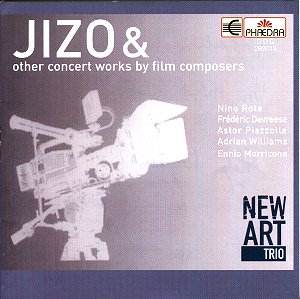Concert Works by Film Composers, the collective
title of the present release, has more than a grain of truth, though
Piazzola and, to a certain extent, Frederik Devreese may not entirely
fit into this category. The other composers, however, have considerably
contributed (and some still do) to that specific medium. All of them,
anyway, have also written a good deal of concert works which are still
too easily by-passed or frankly neglected.
Nino Rota, who may be primarily remembered as the composer
of many original and highly effective scores for Fellini’s films, has
a substantial body of concert works to his credit ranging all the way
from short piano pieces to full-evening operas. His lovely Trio
for clarinet, cello and piano is an appealing example of his tuneful
and colourful music in which most of his fingerprints are much in evidence:
simple structures, economy of means, clarity as well as some light-hearted
humour (as in the Poulenc-like third movement) and deeply felt emotion
(as in the beautifully simple, song-like second movement).
Fréderik Devreese, too, has composed many fine
concert works in an accessible 20th Century idiom as well
as a lot of incidental music and a number of very fine film scores,
particularly for the late André Delvaux for whose masterpiece
L’Oeuvre au Noir he wrote a substantial score of which very little
is actually heard in the film but that, fortunately enough, has been
recorded complete. Delvaux’s Benvenuta (1983) starring Fanny
Ardant and Vittorio Gassman called for a more concentrated approach,
the music being part of the setting, as it were, and more independent
from what happens on the screen. The suite, made by Devreese, exists
in several versions, including for violin and piano and for bass clarinet
and marimba (the latter available on PHAEDRA 292005), for clarinet trio
(heard here) and for orchestra (available on MARCO POLO 8.223681). It
is in fact a dance suite (Habanera, Waltz and Tango) introduced by a
sort of ‘dream sequence’. The most remarkable thing about it is that
all the movements are in fact highly imaginative variations on the same
basic tango, stated in the introduction and which is turned into a nightmarish
danse macabre and in a more aggressive dance number.
Piazzola will probably be best described as the man
who transformed the often vulgar, popular Tango into a sophisticated
art form, and Verano Porteño, which also exists
in several instrumental versions, is a prime example of his approach.
Adrian Williams’ trio Jizo was commissioned
by the New Art Trio and was completed as recently as 2002, so that the
present recording is also the world première of the piece. It
is a suite of three concise, contrasted movements evoking three Japanese
deities who, so we are told, protect children. So Jizo Bosatsu
(peaceful god who saves children from hell), Sendan Kendatsuba
(who kills demons attacking children) and Kariteimo who first
devours children and then repents!). A superbly crafted piece of music
in its own right eschewing any attempt at fake Orientalism.
Though much of his fame rests on his numerous film
scores, some of them being real masterpieces in their own kind, Morricone,
who was a pupil of Petrassi, also composed some considerable concert
work. His Quattro Studi for piano were written between
1983 and 1989. A pity that the whole set has not been recorded here;
but I can understand why the First Study was chosen. Its design has
most Morricone hallmarks that make his music so unique: a few isolated
notes, struck so that they resonate for some time, punctuate an ostinato
that is subtly varied throughout the piece. (I really wonder what the
other études sound like.)
Affectionate, dedicated and well recorded readings
of a varied and attractive programme that vastly repays repeated hearings
and that is well worth looking for.
Hubert Culot


